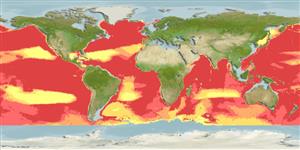分類 / Names
俗名 | 同種異名 | Catalog of Fishes(屬, 種) | ITIS | CoL | WoRMS | Cloffa
Teleostei >
Lophiiformes (Anglerfishes)
鮟鱇目 (Anglerfishes) >
Ceratiidae (Warty Seadevils)
角鮟鱇科 (Warty Seadevils)
Etymology: Ceratias: Greek, keras = horn or horned, refers to the lure projecting from the snout (Ref. 86949).
Eponymy: Henrik Nikolai Krøyer (1799–1870) was a Danish marine biologist. [...] (Ref. 128868), visit book page.
Environment: milieu / climate zone / depth range / distribution range
生態學
海洋 深海區的; 深度上下限 400 - 4400 m (Ref. 74511), usually 400 - 2000 m (Ref. 37729). 深水域; 67°N - 45°S, 180°W - 180°E
Circumglobal: In tropical to temperate waters. Adults (expatriates ?) found in boreal and subarctic waters. South China Sea and East China Sea (Ref.74511).
Circumglobal: 在熱帶到溫帶水域中。 成魚 (遊離棲地 ?) 發現於北與靠近北極的水域了。
大小 / 重量 / 年齡
Maturity: Lm ? range ? - ? cm
Max length : 16.0 cm SL 雄魚/尚未辨別雌雄; (Ref. 7463); 120.0 cm TL (female); common length :77 cm TL (female)
背棘 (總數) : 1; 背的軟條 (總數) : 3 - 4; 臀棘: 0; 臀鰭軟條: 4; 脊椎骨: 20. Branchiostegal rays: 6 (Ref. 36494).
鰓條骨: 6.(參考文獻 36494)
Maximum size observed for free living males is 1.3 cm (Ref. 10524). Males are parasitic, females oviparous with planktonic larvae (Ref. 36494). Eggs are presumably contained in floating gelatinous rafts (Ref. 36494). Minimum depth from Ref. 037729.
給自由生活的雄魚觀察到的最大體長是 1.3 公分。 (參考文獻 10524) 雄性是寄生的, 雌性卵生的仔魚為浮游性.(參考文獻 36494) 卵是可能包覆在漂浮的凝膠狀的筏中.(參考文獻 36494)
Life cycle and mating behavior
成熟度 | 繁殖 | 產卵場 | 卵 | 孕卵數 | 仔魚
Oviparous (Ref. 36494).Circumglobal: 在熱帶到溫帶水域中。 成魚 (遊離棲地 ?) 發現於北與靠近北極的水域了。
Bertelsen, E., 1990. Ceratiidae. p. 510-512. In J.C. Quero, J.C. Hureau, C. Karrer, A. Post and L. Saldanha (eds.) Check-list of the fishes of the eastern tropical Atlantic (CLOFETA). JNICT, Lisbon; SEI, Paris; and UNESCO, Paris. Vol. 1. (Ref. 4494)
IUCN 瀕危狀態 (Ref. 130435: Version 2024-1)
無危 (LC) ; Date assessed: 09 May 2013
人類使用
漁業: 沒有興趣
工具
特別的報告
下載 XML
網路資源
Estimates based on models
Preferred temperature (Ref.
123201): 2 - 9.7, mean 3.8 °C (based on 7133 cells).
Phylogenetic diversity index (Ref.
82804): PD
50 = 0.6875 [Uniqueness, from 0.5 = low to 2.0 = high].
Bayesian length-weight: a=0.01995 (0.00906 - 0.04395), b=3.01 (2.83 - 3.19), in cm total length, based on all LWR estimates for this body shape (Ref.
93245).
營養階層 (Ref.
69278): 3.2 ±0.40 se; based on food items.
Fishing Vulnerability (Ref.
59153): High to very high vulnerability (72 of 100).
